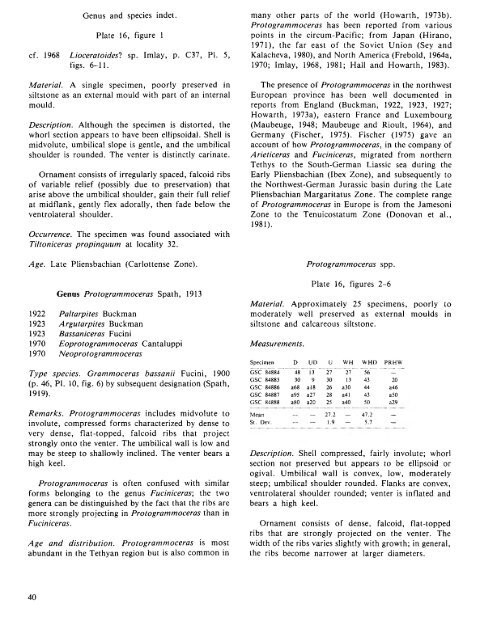PLIENSBACHIAN (LOWER JURASSIC) BIOSTRATIGRAPHY AND ...
PLIENSBACHIAN (LOWER JURASSIC) BIOSTRATIGRAPHY AND ...
PLIENSBACHIAN (LOWER JURASSIC) BIOSTRATIGRAPHY AND ...
Create successful ePaper yourself
Turn your PDF publications into a flip-book with our unique Google optimized e-Paper software.
Genus and species indet.<br />
Plate 16, figure 1<br />
cf. 1968 Lioceratoides? sp. Imlay, p. C37, PI. 5,<br />
figs. 6-11.<br />
M aterial. A single specimen, poorly preserved in<br />
siltstone as an external mould with part of an internal<br />
mould.<br />
Description. Although the specimen is distorted, the<br />
whorl section appears to have been ellipsoidal. Shell is<br />
midvolute, umbilical slope is gentle, and the umbilical<br />
shoulder is rounded. The venter is distinctly carinate.<br />
Ornament consists of irregularly spaced, falcoid ribs<br />
of variable relief (possibly due to preservation) that<br />
arise above the umbilical shoulder, gain their full relief<br />
at midflank, gently flex adorally, then fade below the<br />
ventrolateral shoulder.<br />
Occurrence. The specimen was found associated with<br />
Tiltoniceras propinquum at locality 32.<br />
A ge. Late Pliensbachian (Carlottense Zone).<br />
Genus Protogram m oceras Spath, 1913<br />
1922 Paltarpites Buckman<br />
1923 A rgutarpites Buckman<br />
1923 Bassaniceras Fucini<br />
1970 Eoprotogram m oceras Cantaluppi<br />
1970 Neoprotogram m oceras<br />
Type species. G ram m oceras bassanii Fucini, 1900<br />
(p. 46, PI. 10, fig. 6) by subsequent designation (Spath,<br />
1919).<br />
R em arks. Protogram m oceras includes midvolute to<br />
involute, compressed forms characterized by dense to<br />
very dense, flat-topped, falcoid ribs that project<br />
strongly onto the venter. The umbilical wall is low and<br />
may be steep to shallowly inclined. The venter bears a<br />
high keel.<br />
Protogram m oceras is often confused with similar<br />
forms belonging to the genus Fuciniceras; the two<br />
genera can be distinguished by the fact that the ribs are<br />
more strongly projecting in Protogram m oceras than in<br />
Fuciniceras.<br />
A g e and distribution. P rotogram m oceras is most<br />
abundant in the Tethyan region but is also common in<br />
many other parts of the world (Howarth, 1973b).<br />
Protogram m oceras has been reported from various<br />
points in the circum-Pacific; from Japan (Hirano,<br />
1971), the far east of the Soviet Union (Sey and<br />
Kalacheva, 1980), and North America (Frebold, 1964a,<br />
1970; Imlay, 1968, 1981; Hall and Howarth, 1983).<br />
The presence of Protogram m oceras in the northwest<br />
European province has been well documented in<br />
reports from England (Buckman, 1922, 1923, 1927;<br />
Howarth, 1973a), eastern France and Luxembourg<br />
(Maubeuge, 1948; Maubeuge and Rioult, 1964), and<br />
Germany (Fischer, 1975). Fischer (1975) gave an<br />
account of how Protogrammoceras, in the company of<br />
Arieticeras and Fuciniceras, migrated from northern<br />
Tethys to the South-German Liassic sea during the<br />
Early Pliensbachian (Ibex Zone), and subsequently to<br />
the Northwest-German Jurassic basin during the Late<br />
Pliensbachian Margaritatus Zone. The complete range<br />
of Protogram m oceras in Europe is from the Jamesoni<br />
Zone to the Tenuicostatum Zone (Donovan et al.,<br />
1981).<br />
Protogram m oceras spp.<br />
Plate 16, figures 2-6<br />
M aterial. Approximately 25 specimens, poorly to<br />
moderately well preserved as external moulds in<br />
siltstone and calcareous siltstone.<br />
M easurements.<br />
Specim en D UD U W H W H D PR H W<br />
G SC 84884 48 13 27 27 56 _<br />
G SC 84885 30 9 30 13 43 20<br />
G SC 84886 a68 a!8 26 a30 44 a46<br />
G SC 84887 a95 a27 28 a41 43 a50<br />
G SC 84888 a80 a20 25 a40 50 a29<br />
M ean — 27.2 _ 47.2 _<br />
St. Dev. — — 1.9 — 5.7 —<br />
Description. Shell compressed, fairly involute; whorl<br />
section not preserved but appears to be ellipsoid or<br />
ogival. Umbilical wall is convex, low, moderately<br />
steep; umbilical shoulder rounded. Flanks are convex,<br />
ventrolateral shoulder rounded; venter is inflated and<br />
bears a high keel.<br />
Ornament consists of dense, falcoid, flat-topped<br />
ribs that are strongly projected on the venter. The<br />
width of the ribs varies slightly with growth; in general,<br />
the ribs become narrower at larger diameters.

















